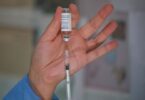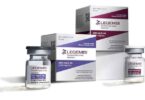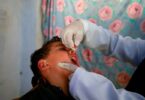WASHINGTON (thehill): The U.S. vaccine map looks a lot like a map of how states vote in presidential elections, with most blue states vaccinating at levels well above the national average and GOP states bringing up the rear.
The politics of COVID-19 have been partisan from almost the onset of the pandemic, and polls consistently show that Republicans, particularly men, are more hesitant than Democrats to get vaccinated.
The deep-blue state of Vermont has the highest share of its population with at least one vaccine dose, at 65 percent, according to data compiled by The New York Times, followed by Massachusetts, Hawaii, New Hampshire and Connecticut.
The top 21 states for vaccination rates all went for President Biden in the 2020 presidential election. Iowa — with 47 percent of its population receiving at least one shot — is the highest ranking state on the list, at No. 22, that voted for former President Trump.
The state with the lowest vaccination rate, Mississippi, at 32 percent, is deeply red, as are the other four states that round out the bottom five: Louisiana, Alabama, Wyoming and Idaho.
“It does appear to be the case that states that voted for Biden in the 2020 election, in general or on average, appear to have higher vaccination rates than states that voted for Trump,” said Jennifer Tolbert, director of state health reform at the Kaiser Family Foundation.
Survey results reveal a big reason why. An NPR-PBS-Marist poll this month found that 41 percent of Republicans said they are not going to get vaccinated, compared to just 4 percent of Democrats who said the same.
“Our country is profoundly politicized,” said Monica Gandhi, an infectious diseases expert at the University of California, San Francisco, in explaining the gap in vaccination rates.
There are also some intriguing anomalies in the data. Pennsylvania, a swing state that voted for Biden last year, has a vaccination rate of 55 percent with at least one shot, exceeding the national average of 47 percent.
Meanwhile, two other states that voted for Biden — Georgia and Arizona — are at 37 percent and 44 percent, respectively.
Doug Heye, a Republican strategist, said those figures could align with the view that the 2020 presidential election results in Georgia were more of an “anomaly.”
“I still view Georgia as a Republican state,” he said.
Experts caution that there are other factors at play in vaccination rates. Tolbert, of the Kaiser Family Foundation, said Pennsylvania’s higher rate is not necessarily a reflection of it trending more toward Democrats but could be due to other variables like the efficiency of its vaccination campaign.
Megan Ranney, a public health expert at Brown University, said another factor is that red states tend to have less well-funded public health infrastructure, which could make getting shots in people’s arms more difficult.
“There certainly is a difference, but that doesn’t explain all of the difference,” she said. “It’s not just politics.”
Shobita Parthasarathy, a public policy professor at the University of Michigan, noted that some states with rural and urban areas also face challenges.
“Michigan is sort of a purple, leaning blue, state and you have less vaccination in the more rural areas but you also have less vaccination in Detroit,” she said, noting that hesitancy can come from different groups.
Like many swing states, Michigan is more toward the middle of the pack when it comes to vaccinations.
Given the hesitancy among Republicans, discussion has swirled around getting Trump to more actively encourage vaccinations. The former president has said he recommends getting the shot but has not made that message priority. And when he received his shots as president, he did not do so on camera like many other world leaders have done.
Heye noted that Trump will be speaking to the North Carolina Republican convention on June 5 and said it could go a long way if he gave a push for vaccinations in his speech. The state party could even offer shots on site, Heye suggested.
“That could be a big boost,” he said.
The White House has been looking to get local doctors more involved in the vaccination campaign, given that many people tend to trust their own doctor over government officials.
Paul Beck, an emeritus professor of political science at Ohio State University, said his state’s relatively low vaccination rate, at 43 percent, comes at a time when Republicans have been doing increasingly well in what was once consistently the nation’s biggest battleground state.
“There are a lot of people in Ohio, maybe a majority these days, who are sympathetic to the Trump side of things,” Beck said.
“Obviously, Republicans are more hesitant to get the vaccine,” he added.
Gandhi, the University of California expert, said the new guidance from the Centers for Disease Control and Prevention (CDC) last week that vaccinated people do not need to wear masks in most places could serve as an incentive for more people to get the shot.
While the guidance was scientifically sound, “they’re also trying to motivate,” she said of the CDC.
Ranney, of Brown University, worried that some states won’t improve their vaccine rates, and that the country will “have persistent differences in vaccination rates.”
“For those Southern states, they’re all heading indoors to air conditioning,” where the virus spreads more easily, over the summer, she said. “I am concerned about those states.”






